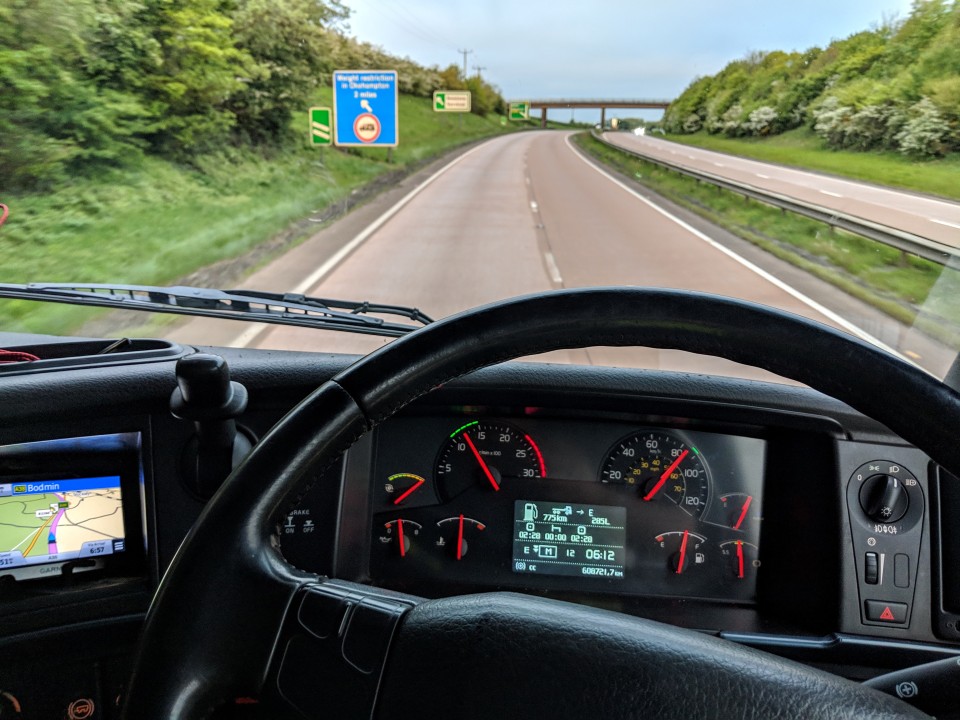
Susie Jones
Vi annoiate in viaggio?
Creato: 27/08/2024
•
Aggiornato: 27/08/2024
Un camionista medio trascorre circa 12 ore al giorno al volante. Il tempo infinito sulla strada aperta può sembrare allettante, ma la realtà è in netto contrasto. Le innumerevoli stazioni di servizio, le aree di sosta e le lunghe ore possono diventare noiose. I camionisti trascorrono spesso i loro tempi morti lontano da casa e prevenire la noia può essere una sfida.
Secondo un recente sondaggio di Convoy, la noia è una delle principali sfide per i camionisti. Che effetto ha la noia sul benessere dei conducenti? E come possono i camionisti intrattenersi?
Come la noia influisce sul benessere dei conducenti
Stanchezza, isolamento, solitudine e mancanza di stimoli mentali sono preoccupazioni comuni per gli autisti. Alcuni conducenti possono affrontare queste preoccupazioni con meccanismi di coping poco salutari, come mangiare troppo, fumare o consumare eccessivamente caffeina. Nel tempo, queste abitudini possono avere un impatto negativo sulla salute mentale.
Tuttavia, con il miglioramento dei discorsi sulla salute mentale, sempre più autisti stanno prendendo una strada diversa per combattere il problema. Abbiamo chiesto ai camionisti su Facebook cosa fanno quando la noia si fa sentire.
"Audiolibri, soprattutto di psicologia. Musica, chiacchiere con i miei cari o ascolto la radio. Oppure spengo tutto e mi concedo un'esistenza tranquilla con i miei pensieri", dice Nigel.
Altri hanno raccontato che parlare con i propri cari al telefono è stato d'aiuto. Ashleigh afferma:
"Parlare con i miei amici in una chat di gruppo. Onestamente, se non avessi avuto loro, avrei smesso molto tempo fa. La strada presenta dei rifiuti e senza parlare con dei buoni amici non sarei mai sopravvissuto".
Allo stesso modo, Karl ritiene che una "chat di gruppo con gli amici sia un must".

Prevenire la noia al volante
Contrariamente a quanto si crede, l'autotrasporto è un'attività fisica: gli autisti hanno bisogno di coordinazione e concentrazione per evitare incidenti. Tuttavia, stare al volante per periodi prolungati può causare stanchezza. Il rischio di diventare compiacenti sul lavoro può verificarsi, soprattutto se l'autista conosce bene il proprio percorso. Come possono gli autisti affrontare l'autocompiacimento al volante?
Che si tratti di ascoltare un podcast o un brano orecchiabile, gli automobilisti devono scegliere qualcosa che tenga la mente sveglia. Abbiamo stilato un elenco di cose da fare per evitare la noia al volante.
Podcast: Il camionista Marty ascolta "decine di podcast" mentre guida. I podcast sono un modo eccellente per cambiare le cose e imparare qualcosa di nuovo. Date un'occhiata a questo utile elenco di podcast per autotrasportatori
Musica: "Musica, musica e ancora musica" è l'antidoto alla noia di Richard. Che si tratti di ascoltare la radio o di cantare con una playlist, la musica è un modo eccellente per mantenere la mente vigile.
Prendetevi una pausa: Anche se gli autisti devono rispettare scadenze rigide e regole del tachigrafo, uscire dalla cabina quando la noia si fa sentire aiuta la mente a concentrarsi.
Noia durante i tempi morti
I camionisti devono affrontare ulteriori sfide per intrattenersi dopo il turno. È indispensabile adottare un approccio proattivo per evitare la noia durante questo periodo. Abbiamo compilato un elenco di modi per passare le ore.
Posizione: Le aree di sosta per camion che offrono una vasta gamma di servizi e un'atmosfera comune sono un modo eccellente per alleviare la noia. Alcune fungono da centro sociale dove i camionisti possono condividere esperienze simili. Visitate la nostra [pagina delle sedi] (https://www.snapacc.com/locations/?lang=EN) per vedere quali strutture offrono i nostri partner del servizio SNAP.
Fare esercizio fisico: Una passeggiata giornaliera o un allenamento creativo possono evitare la noia e garantirvi una buona forma fisica. Date un'occhiata ai nostri consigli per rimanere sani in viaggio
Servizi di streaming: Per seguire l'ultimo programma televisivo o scorrere i social media. Al camionista Steve piace "scorrere e commentare su Facebook e guardare Netflix" per passare il tempo.
Hobby: Le opportunità sono infinite. Imparare uno strumento, imparare una lingua straniera, disegnare, scrivere e molto altro. Dedicarsi a un hobby è un modo efficace per prevenire la noia.
Cucinare: Cucinare in cabina ha molti vantaggi. Non solo evita la noia, ma fa risparmiare denaro ed è più salutare.
Rimanere in contatto con i propri cari: I tempi morti di un camionista sono l'occasione perfetta per contattare le persone più care. Le videochiamate sono un modo efficace per sentirsi più vicini alla famiglia e agli amici.
Rilassarsi: i camionisti possono trovarsi ad affrontare situazioni stressanti. Rilassarsi completamente dopo un turno può migliorare il benessere del conducente. Tecniche di rilassamento come esercizi di respirazione profonda e meditazione riducono lo stress.
Anche se alcuni conducenti amano la solitudine e l'indipendenza che la strada aperta offre, combattere la noia è ancora una sfida per molti. A causa della natura del lavoro, i camionisti spesso sperimentano lunghi periodi di noia. Tuttavia, per migliorare il benessere, la soddisfazione sul lavoro e la sicurezza stradale, devono trovare il modo di alleviarla. Che si tratti di concentrarsi sul compito da svolgere, di ascoltare la radio o di chiacchierare con amici e familiari, la maggior parte dei camionisti riesce a trovare una soluzione che vada bene per loro.

Dove dormono i camionisti?
La maggior parte degli autisti dorme in cabina, perché è ben attrezzata per un sonno confortevole. Una cabina letto di base comprende un letto, un ripostiglio, luci e prese elettriche, che la rendono una casa lontana da casa.
A causa dell'attuale carenza di parcheggi in Europa, molti automobilisti parcheggiano nelle piazzole di sosta. Questa pratica è ritenuta poco sicura e rende l'autista vulnerabile ai furti. A partire da novembre 2017, i conducenti di mezzi pesanti nel Regno Unito devono effettuare regolari pause di riposo settimanali in aree di sosta adeguate (come le aree di servizio e gli autogrill).
Il programma SNAP's Depot Parking consente alle flotte di offrire i propri posti auto alla rete, alleviando la carenza e aiutando gli autisti a evitare situazioni di vulnerabilità. Inoltre, SNAP mette a disposizione degli autisti oltre 450 partner di servizio in tutta Europa. Per saperne di più, visitate la nostra pagina delle mappe.
Perché i camionisti lasciano le porte dei rimorchi aperte?
Se vi è capitato di percorrere una strada principale di notte, avrete notato dei camion parcheggiati con le porte del rimorchio aperte. Molti conducenti lo fanno per scoraggiare i ladri, partendo dal presupposto che se il portellone del rimorchio è aperto non c'è nulla da rubare. Questo avviene soprattutto sui rimorchi a tendina, in quanto impedisce ai ladri di tagliare la tendina per vedere cosa c'è all'interno.



